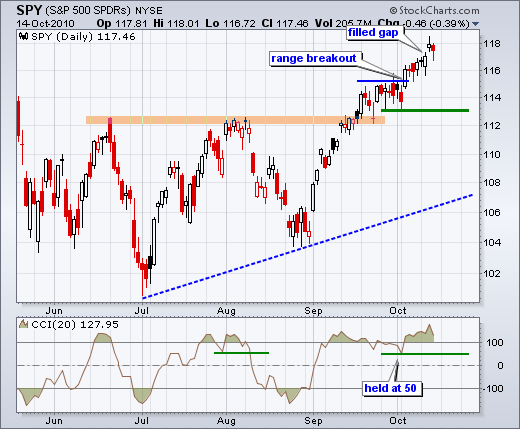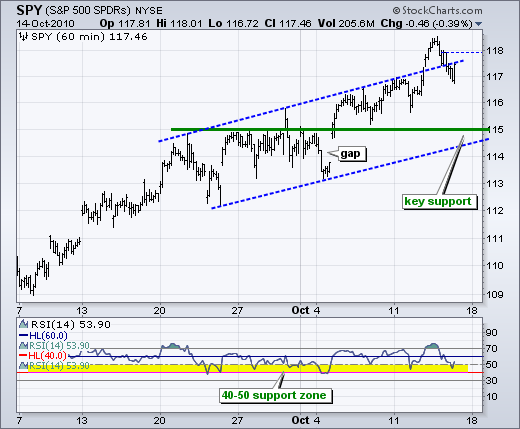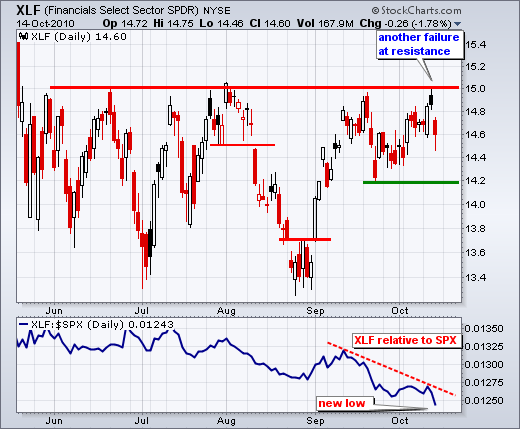The finance sector remains a thorn in the bull's hoof. Even though majority of the market is in bull mode, the Finance SPDR (XLF) remains a serious laggard. As noted in Wednesday's Market Message, XLF is the only one of the nine sector SPDRs that has yet to clear its summer highs. XLF failed once again with a gap down and red candlestick on Thursday. The chart below shows the price relative moving to yet another new lows as big banks remain out of favor on Wall Street. In fact, big banks are so out of favor they are not even attracting the contrarians. How's that for unloved. A break above 15 is needed to put XLF on the bullish track.
There is no change on the daily chart. The bulls rule the roost and there is nothing to do but watch or ride. SPY is still overbought by several yardsticks, but shows no weakness on the actual price chart. Since surging to its summer highs around 112, SPY has been grinding higher the last 4-5 weeks. Upside momentum may be less than before, but there is clearly no downside momentum. The ETF filled Wednesday's gap with a dip below 117 intraday, but bounced to close with a small loss on the day. Key support remains at 113 on the daily chart. CCI support is set at 50.

There is no real change on the 60-minute chart. SPY broke above the upper trendline of the rising price channel, but fell back into the channel on Thursday. Despite this overbought setback, the trend is clearly up. I am watching broken resistance at 115 and the lower trendline of the rising channel for support. RSI support is set in the 40-50 zone. In fact, RSI dipped into this zone on Thursday for a test.

Key Economic Reports:
Oct 15 - 08:15 - Ben Bernanke Speaks
Oct 15 - 08:30 - CPI
Oct 15 - 08:30 - Retail Sales
Oct 15 - 08:30 - NY Fed Empire Manufacturing Survey
Oct 15 - 09:55 - Michigan Sentiment
Charts of Interest: Tuesday and Thursday.
-----------------------------------------------------------------------------
This commentary and charts-of-interest are designed to stimulate thinking. This analysis is not a recommendation to buy, sell, hold or sell short any security (stock ETF or otherwise). We all need to think for ourselves when it comes to trading our own accounts. First, it is the only way to really learn. Second, we are the only ones responsible for our decisions. Think of these charts as food for further analysis. Before making a trade, it is important to have a plan. Plan the trade and trade the plan. Among other things, this includes setting a trigger level, a target area and a stop-loss level. It is also important to plan for three possible price movements: advance, decline or sideways. Have a plan for all three scenarios BEFORE making the trade. Consider possible holding times. And finally, look at overall market conditions and sector/industry performance.

About the author:
Arthur Hill, CMT, is the Chief Technical Strategist at TrendInvestorPro.com. Focusing predominantly on US equities and ETFs, his systematic approach of identifying trend, finding signals within the trend, and setting key price levels has made him an esteemed market technician. Arthur has written articles for numerous financial publications including Barrons and Stocks & Commodities Magazine. In addition to his Chartered Market Technician (CMT) designation, he holds an MBA from the Cass Business School at City University in London.
Learn More






